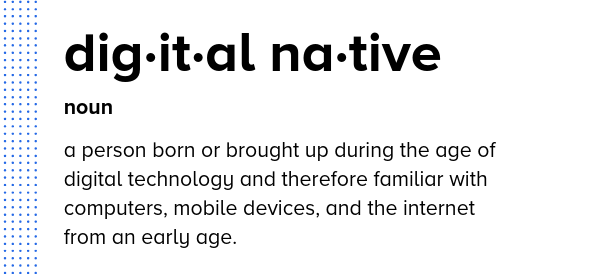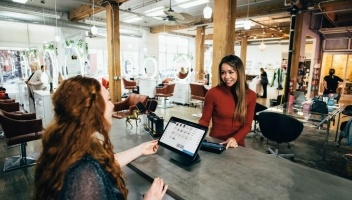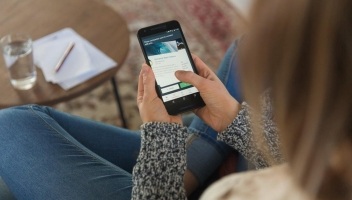Designing for digital natives: Are you ready for Generation Z?

For years now, it seemed like you couldn’t go a day or two without seeing a headline about Millennials. Millennials are taking over the workforce, Millennials killed the shopping mall, Millennials eat a lot of avocado toast. It made sense that everyone was so interested in this generation—it’s been predicted that Millennials will outnumber Baby Boomers by the end of 2019. But while the world was obsessing over Millennials, a new generation is coming of age: Generation Z (Gen Z), the digital natives.

Gen Z is a generation of digital natives, surrounded by technology and interactive devices and environments since birth. They don’t know a world without the internet, smartphones, Netflix, Uber, or Amazon.
With Pew Research Center estimating 7.1 million Gen Zers in the US alone and expects the size of this generation to eclipse that of Millennials in the near future. This latest generation of consumers has been immersed in a digital world before they could walk or talk—it’s all they’ve ever known.
Generation Z will fundamentally change how we approach experience design in the near future. The biggest challenge will be bridging the empathy gap between those creating experiences for Gen Z, and Gen Zers themselves.
According to a study by ZeroCater, 98% of Gen Zers have a mobile device, and 50% spend at least 10 hours per day online. Considering that most people in this group are still in school, that’s a considerable amount of their time—and attention—spent in the digital realm.
For those fighting for a more customer-centric focus for the past several years—or decades— it’s hard to imagine that all we’ve been advocating for may be changing. Unsettling as it may be, here we are.
The good news is that if you’re relying on human insight to guide your product development, you’ll always be in a position to connect with any generation. To help prepare you for the rise of Gen Z, we’ve outlined a few key ways this generation differs from others, and how you can capture valuable insight to help create products and experiences they’ll love.
No time for patience
This is one area in which Gen Z is similar to other generations—they’re impatient just like everyone one else. The difference may be in just how impatient they are. Some reports show that Gen Zers have an attention span of about eight seconds.
When studying college student’s laptop habits, San Diego State University psychology professor, Jean Twenge, notes in her book, iGen, that,
...students switched between tasks every nineteen seconds on average. More than 75% of the students’ computer windows were open less than one minute.
Those students, if they aren’t already, will soon become employees and consumers that expect near-instant gratification from most experiences.
While instant (or nearly instant) gratification isn’t always possible, there are ways to help mitigate delays or interruptions in an experience. Paying close attention to onboarding flow, error messages, help text, and the like will help reassure impatient users—hopefully keeping them engaged.
You can test this by putting everything from concepts to prototypes to fully-developed products into the hands of Gen Z consumers. Gather quantitative data like time on task, or satisfaction ratings, just to name a few, then schedule follow up interviews to dive deeper to understand when and where users ran out of patience.
Digital natives don’t always prefer digital
Gen Zers habits can be counterintuitive. While they’ve grown up in a digital world and have high expectations for seamless, fast experiences, that doesn’t mean that they don’t appreciate a more human touch. After growing up with digital experiences all around them, this generation more than others before it, are starting to feel the pains of the empathy gap.
While companies raced to kick off digital transformations to keep up with technological advancements, some consumers, notably Gen Z, started to feel a disconnect between brands and the digital experiences they provided.
Despite all the talk of a “retail apocalypse” threatening the livelihood of brick-and-mortar stores, that’s exactly where Gen Z consumers prefer to shop. Perhaps all that time spent connected to their devices or being online has left them with a need to connect with the real world. According to research by the National Retail Federation, 67% of Gen Z consumers prefer to do their shopping in-store, rather than online.
However, that doesn’t mean the digital experience doesn’t influence purchases. Nearly half of Gen Zers “showroom” before making purchases—researching online, then visiting a brick-and-mortar store to make a purchase. They’re relying on their smartphones, computers, and tablets to consider purchases before ever setting foot in a store.
With Gen Z representing an estimated 40% of consumers by 2020, that’s an important aspect of the customer experience to note. While omnichannel experiences might not be as exciting as emerging trends like AI, as UserTesting’s recent CX Industry Report shows, it’s clearly something the future generation of consumers values.
Keep up with Gen Z by testing your experiences across all channels to assure a seamless interaction that represents your brand’s values and mission. Watching what Gen Z consumers do, what they say, and hearing them explain their actions is your best strategy to bridge the empathy gap and connect with your customers at every touchpoint.
It’s not me, it’s you
Traditional usability and empathy best practices tell us that when a product or experience doesn’t work properly, users tend to assume that they did something wrong. Error messages, 404 pages, notification emails—they’re all positioned to take as much weight of responsibility as possible off the user to avoid making them take the blame for something not working quite right.
With Gen Z, however, those days may be over. Studies show that when something goes wrong, digital natives assume that it’s the technology that’s at fault, not them.
This generation has been raised in an on-demand, instant gratification society. No one in this generation remembers dial-up internet, or dot matrix printers. Even waiting in line at the DMV seems ridiculous (to be fair, that’s probably a universal truth).
This means that whatever goodwill a brand may have had with consumers previously, might meet a short fuse with Gen Z consumers. Digital natives, more so than previous generations, have high expectations and a low tolerance for failure or inconvenience. Companies need to be mindful of how customers experience friction and handle those situations with care.
While the best practice of a general, “We’re sorry, something went wrong” messaging may have worked in the past, that might not cut it with Gen Zers. You can gather valuable human insight on this by testing what happens when things go wrong with a Gen Z audience. Watch what they do, and listen to what they say to gain a better understanding of what motivates them.
We’ve created a generation that expects perfection
The drive to create better experiences for previous generations has set a high standard, and that’s a good thing! We all benefit from brands stretching themselves to better connect with their customers.
The next generation of consumers has been trained by those before them to expect nothing but the best from the brands they interact with. To survive and thrive in the Experience Economy, brands must fully commit to incorporating human insight into their company culture and product development.
Want to learn more?
To learn how UserTesting can help you understand your customers through on-demand human insight, contact us here.
Welcome to the Experience Economy
Learn how organizations are adapting to meet the ever-changing needs of consumers in the Experience Economy.







